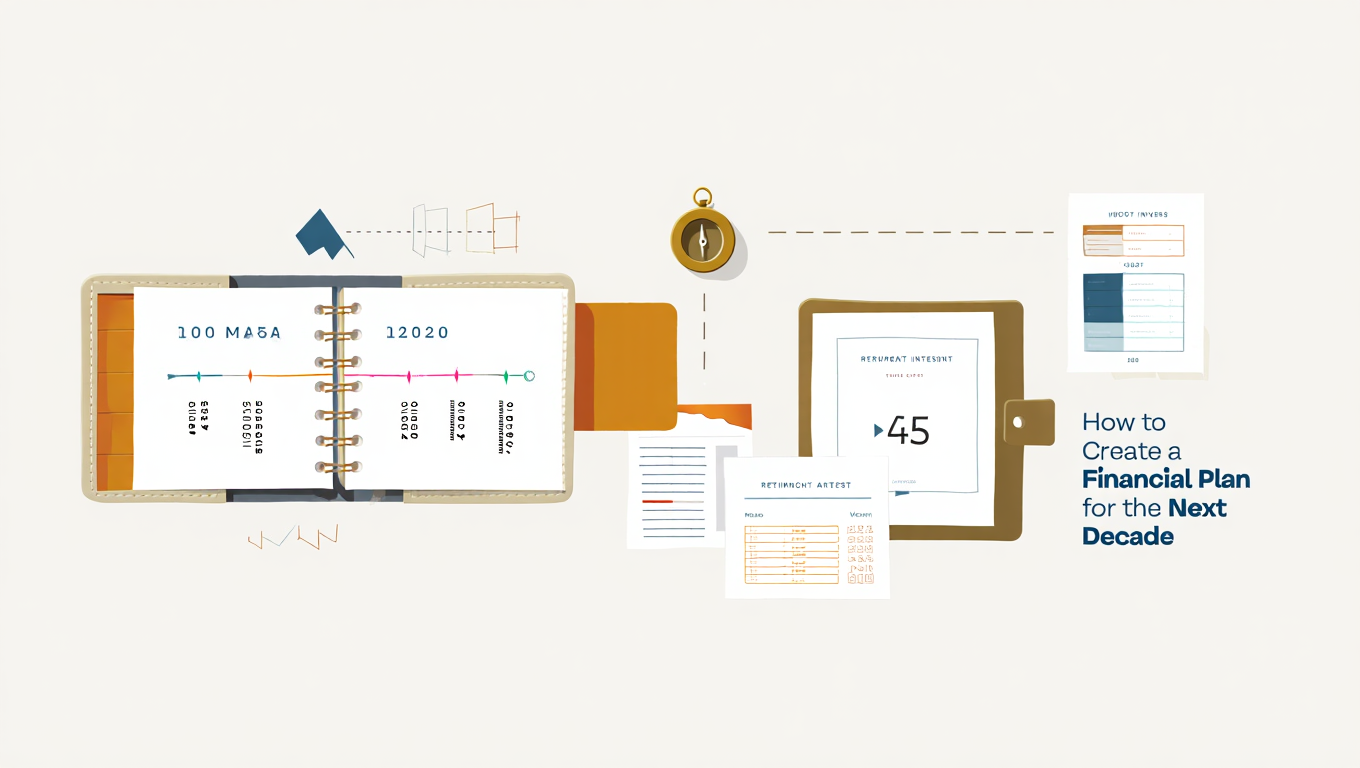
Planning your finances for the next 10 years may feel overwhelming, but it doesn’t have to be. Whether you want to retire early, buy a house, start a business, or travel the world, a strong financial plan gives you the roadmap to make it happen. In this guide, you’ll learn exactly how to create a decade-long financial plan that’s flexible, realistic, and tailored to your goals.
📌 Why Plan for the Next 10 Years?
Short-term budgeting helps you stay afloat. Long-term planning helps you thrive.
A 10-year financial plan allows you to:
- ✅ Set and achieve major life goals (home ownership, early retirement, kids’ education)
- ✅ Reduce financial stress through clear direction
- ✅ Build wealth intentionally
- ✅ Prepare for life’s uncertainties (job changes, inflation, family changes)
Bottom line? Ten years goes faster than you think. Planning today gives you more control tomorrow.
🧭 Step 1: Define Your 10-Year Life Vision
Before jumping into numbers, start with the life you want.
Ask yourself:
- Where do I want to live?
- Do I want to own property or rent long-term?
- Will I start a family, send kids to college, or support loved ones?
- Do I want to retire or reach financial independence early?
- What kind of lifestyle do I want (modest, comfortable, luxurious)?
- Will I change careers, go back to school, or launch a business?
💡 Pro Tip: Don’t just think about money. Think about values, lifestyle, and priorities. Your financial plan is a tool, not the goal.
🧮 Step 2: Calculate Your Current Net Worth
To plan forward, you need to understand where you stand right now.
Net Worth = Assets – Liabilities
List all your:
Assets
- Cash and bank account balances
- Investments (stocks, bonds, crypto, retirement accounts)
- Real estate (home equity)
- Vehicles (if owned outright)
- Business equity
Liabilities
- Mortgage balance
- Credit card debt
- Student loans
- Personal loans
- Medical debt
💡 Use tools like Personal Capital or a spreadsheet to track this annually.
🏁 Step 3: Set SMART Financial Goals
Break your 10-year vision into clear, achievable financial goals using the SMART method:
- Specific
- Measurable
- Achievable
- Realistic
- Time-bound
Examples:
- Save $50,000 for a house down payment in 5 years
- Pay off $30,000 in student loans in 3 years
- Reach $300,000 in net worth by age 40
- Invest 15% of income annually for retirement
Write these goals down. Break them into short-, medium-, and long-term targets.
💸 Step 4: Create a Long-Term Budget
Use a 10-year budgeting framework to align your income, spending, and savings with your goals.
Suggested Breakdown:
- Essential Spending (50–60%) – Rent/mortgage, groceries, transportation, insurance
- Savings & Investments (20–30%) – Retirement, emergency fund, brokerage accounts
- Lifestyle Spending (10–20%) – Dining out, entertainment, vacations
💡 Use the 70/20/10 Rule as a starting point, then customize based on your income and goals.
🧾 Bonus Tip: Use budgeting apps like YNAB, Monarch Money, or a simple Google Sheet.
🧱 Step 5: Build a Strong Emergency Fund
Financial plans fall apart without a safety net.
Target:
Save 3–6 months of expenses in a high-yield savings account. If you’re self-employed, aim for 9–12 months.
Why it matters:
- Covers unexpected job loss, medical bills, or car repairs
- Prevents reliance on credit cards or loans
- Protects long-term investments from early withdrawals
🪙 Step 6: Optimize Your Income
The more you earn, the faster you reach your goals.
Increase income by:
- Negotiating a raise or promotion
- Adding a side hustle or freelance work
- Launching a scalable digital product or service
- Investing in skills or certifications with high ROI
Tip: Focus on increasing earning potential over the next decade through career growth or entrepreneurship.
📈 Step 7: Create a Long-Term Investment Strategy
Investing is essential for wealth-building over a 10+ year horizon.
Follow these core principles:
- Start early and stay consistent – Time in the market beats timing the market
- Diversify – Mix of index funds, ETFs, and retirement accounts
- Use tax-advantaged accounts – 401(k), IRA, HSA
- Automate contributions – Set it and forget it
Example Portfolio Allocation:
- 70% stocks (U.S. & international)
- 20% bonds
- 10% alternative assets or cash reserves
🔍 Consider consulting a financial advisor or using robo-advisors like Betterment or Wealthfront.
🧾 Step 8: Plan for Major Expenses
Map out expected big-ticket expenses over the decade:
- 🏠 House down payment
- 🚗 New car (if needed)
- 🎓 Kids’ education
- ✈️ Travel or sabbaticals
- 🏥 Medical or fertility treatments
Estimate future costs and assign timelines and monthly savings goals to each.
Bonus Tip: Open separate sinking funds or savings accounts for each goal to stay organized.
🏦 Step 9: Protect Your Plan With Insurance
Insurance is about risk management, not just monthly premiums.
Essential coverage to review:
- Health insurance – Choose plans that match your needs
- Term life insurance – If you have dependents
- Disability insurance – Often overlooked but vital for income protection
- Renter’s/home insurance – Protect your assets
- Umbrella policy – For high-net-worth individuals
🛡️ Think of insurance as a financial firewall—not an expense, but protection for your entire plan.
✍️ Step 10: Create a Will and Estate Plan
If you’re building wealth, protect it with the proper legal documents.
Key documents to consider:
- Last Will and Testament
- Healthcare Proxy
- Power of Attorney
- Living Will
- Trusts (for larger estates or dependents with special needs)
📝 Pro Tip: Online tools like Trust & Will or LegalZoom can help you get started affordably.
📅 Step 11: Schedule Annual Financial Checkups
Your life and goals will evolve. Your financial plan should too.
Review annually:
- Budget and expenses
- Net worth progress
- Investment performance
- Insurance policies
- Goal timelines
- Estate documents
💡 Block out time each year—maybe every January or after tax season—to update your numbers and make adjustments.
📊 Infographic Summary: The 10-Year Financial Plan Checklist
✅ Define your vision
✅ Calculate your net worth
✅ Set SMART financial goals
✅ Build a flexible budget
✅ Fund an emergency account
✅ Grow your income
✅ Invest strategically
✅ Plan for major expenses
✅ Get the right insurance
✅ Create estate documents
✅ Review annually
🔁 Frequently Asked Questions (FAQs)
❓ Can I create a 10-year financial plan without a financial advisor?
Yes. Many people successfully plan on their own using spreadsheets, budgeting tools, and investing platforms. A financial advisor is helpful for more complex situations, but not mandatory.
❓ What if my goals change?
They will—and that’s okay. A good plan is flexible. Review and adjust your plan each year or after major life events.
❓ How detailed should my 10-year plan be?
Start broad, then zoom in. Year 1–3 can be specific; Years 4–10 can be more high-level with estimates.
🎯 Final Thoughts: Build Wealth With Intention
Creating a financial plan for the next decade isn’t just about money—it’s about living on purpose.
When you know where you’re headed and have a plan to get there, every financial decision becomes easier. You’ll feel more confident, focused, and free to enjoy life along the way.
Start today. Your future self will thank you. 👉 Shop for Financial Trackers Now and take the first step toward financial mindfulness today.


